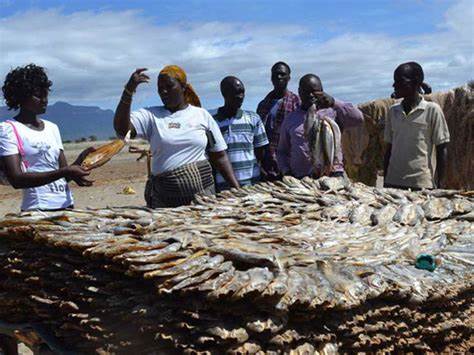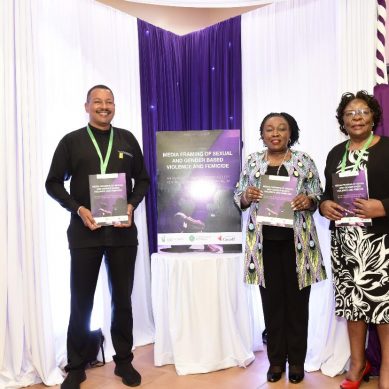
Despite being Kenya’s leading exporter of fish, Turkana County is yet to co-opt women and the youth into the blue economy to realise its full potential.
As a result, Turkana Deputy Governor John Erus wants stakeholders in the fishing industry to make the sector more inclusive by empowering women and youth through training in blue economy.
However, illegal smuggling remains a major the county and by extension the country is grappling with.
Studies have shown the Democratic Republic of Congo is the leading market for Lake Turkana fish. The lake produces more than 7,000 tonnes of fish per annum and most of it is exported to DRC, fetching the country at $500 million.
Farmers Review Africa, “Trade-in fish exports to DRC have been going on for many decades although, with intermittent disruptions occasioned by a misunderstanding between Kenya and Uganda on the source of the fish.”
However, a recent signing of the framework has eased the transportation of the commodity through Uganda to DRC without interference.
Kenyan fish traders operating in Busia town export fish to eastern DRC that border Uganda. Their exports end up in Bukavu, Kisangani, Goma and other eastern DR Congo cities, earning Kenya more than $50 million per annum, the online publication says.
While data on quantities and earnings from legal fish exports is scanty, international investigators, Institute for Security Studies, estimate the 300 tonnes of fish valued at over $1.7 million from Lake Turkana is smuggled to DRC and Zambia.
ISS, which specialises in transnational organised crime, notes, “As corrupt officials from Kenya to the DRC prosper, the world’s only permanent desert lake faces ecological disaster. Lake Turkana in northern Kenya loses hundreds of tonnes of immature tilapia fish monthly through smuggling. Harvesting the fish threatens the existence of the entire species and the unique ecology of the world’s only permanent desert lake. It also diminishes the food security of local communities who depend on tilapia for sustenance and income, and leads to a loss of revenue for both Turkana county and Kenya’s government.”
“In November 2021”, ISS report says, “the Ugandan Fisheries Protection Unit confiscated 300 tonnes of immature dry fish worth US$1,712,329 at the Mpondwe border in Kasese District. The fish originated from Kalokol, a town on Lake Turkana’s shore and were destined for the Democratic Republic of the Congo.”
Latest Kenya Marine and Fisheries Research Institute rep published in May 2021 ort shows that the lake has the capacity to produces over 10,000 tonnes of per annum. However, poor harvesting and handling methods diminishes the quantities significantly.
“Dry fish being stored are normally attacked by insects especially in stores where bulk storage of dried fish are done. Total fish landed was about 7,000 metric tonnes of which tilapia constituted about 83 per cent (5,870 tonnes) of the same. All these areas of high losses need intervention if the losses are to be reduced. The loss at production of about 18 per cent was considered high taking in consideration that the total annual tilapia production of over 5,850 metric tonnes were recorded in the seven BMUs assessed,” according to Kenya Marine and Fisheries Research Institute report.
Against this backdrop, speaking during a multi-stakeholder meeting organised through the County Department of Trade, Gender and Youth Affairs, Erus underlined the untapped potential of Lake Turkana as a blue economy resource that, if properly harnessed, could provide immediate employment for thousands of women and youth in Turkana and beyond.
“We must increase the participation of youth and women in this sector. With the right skills and tools, they can transform their lives while contributing to the economic development of our county,” Erus says.
The meeting brought together representatives from Trademark Africa, the Association of Women in Fisheries and Blue Economy in Kenya (AWFBEK), Kenya Fisheries Service (KFS), Africa Women’s Fish Processors and Traders Network (AWFISHNET), Kenya National Chambers of Commerce and Industry (KNCCI), Microwave Consulting, Lattice Aqua Culture and the Kenya Export Promotion and Branding Agency (KEPBA).
The deputy governor welcomed plans by the sector players to train youth and women-led groups in Turkana, noting that such initiatives would help build local capacity to fully exploit opportunities within the blue economy while improving household incomes.
He reiterated the county’s commitment to supporting inclusive growth by creating an enabling environment through legislative frameworks aligned with national laws on trade, commerce, export promotion, and sustainable resource use.
“We commit to collaborate with all partners to promote entry of women and youth into profitable ventures in the blue economy, such as fishing and aquaculture,” he says.
Kenya Fisheries Service official Willis Onyango, speaking on behalf of the industry players affirmed stakeholders’ commitment to working with the county government to develop the sector.
Onyango noted that Turkana and its partners had already invested heavily in reducing post-harvest losses through improved fish smoking techniques and strengthening value chains. He said these are interventions that have increased the sector’s capacity to absorb more youth and women.
“From May 27-29, we plan to train youth, women and their respective groups on how to harness the potential of the lake and engage meaningfully in the blue economy. This will be done through the Women and Youth Empowerment in Fisheries through Inclusive Market Access (WYEEFIMA) programme,” Onyango announced.
The forum also explored strategies to utilise existing infrastructure such as the ICT and fish processing facility in Loropio for ongoing capacity building. Other discussions focused on exploring regional markets in East Africa, promoting export-oriented trade, and strengthening decision-making through evidence-based research.
Before meeting with the deputy governor, the delegation held a consultative session with the county department of trade, gender, youth affairs and tourism.
It is expected that the training will among other benefits expose the youth and women led groups aspiring to join the blue sector economy value chains, know about export procedures for fish and trade opportunities in the fishing industry.
- A Tell Media / KNA report / By Peter Gitonga
Turkana Deputy Governor Dr John Erus chairs a multi-stakeholder meeting organized through the County Department of Trade, Gender and Youth Affairs where he emphasized the need to tap the potential of Lake Turkana as a blue economy resource.
Turkana Deputy Governor Dr. John Erus (in a flowered shirt in front row) after a meeting with representatives from Trademark Africa, the Association of Women in Fisheries and Blue Economy in Kenya (AWFBEK), Kenya Fisheries Service (KFS), Africa Women’s Fish Processors and Traders Network (AWFISHNET), Kenya National Chambers of Commerce and Industry (KNCCI), Microwave Consulting, Lattice Aqua Culture and the Kenya Export Promotion and Branding Agency (KEPBA).







